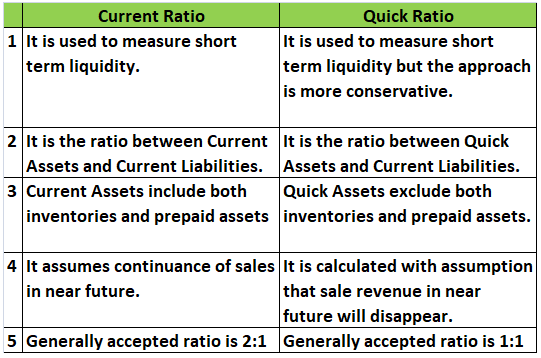No, they are not the same. They are both used to measure the short term liquidity of a business but their approach is different. Following are the differences between the two : Let’s take an example. Following is the balance sheet of X Ltd: Hence, as per the following information, Current Ratio = CuRead more
No, they are not the same. They are both used to measure the short term liquidity of a business but their approach is different. Following are the differences between the two :

Let’s take an example.
Following is the balance sheet of X Ltd:

Hence, as per the following information,
Current Ratio = Current Assets / Current Liabilities
= Inventories + Trade debtors + Bills receivables + Cash and bank + Prepaid Expenses / Trade Creditors + Bills Payables + Outstanding Salaries
= ₹85,000 + ₹2,50,000+ ₹95,000 + ₹1,50,000 + ₹10,000/ ₹2,00,000 + ₹75,000 + ₹25,000
= ₹6,00,000 / ₹3,00,000
= 2/1 or 2:1
Quick Ratio = Quick Assets / Current Liabilities
= Trade debtors + Bills receivables + Cash and bank / Trade Creditors + Bills Payables + Outstanding Salaries
= ₹2,50,000+ ₹95,000 + ₹1,50,000 / ₹2,00,000 + ₹75,000 + ₹25,000
= ₹5,05,000/ ₹3,00,000
= 41 / 25 or 1.68 : 1
Let’s discuss both ratios in detail.
1. Current ratio:
The current ratio represents the relationship between current assets and current liabilities
Current ratio = Current Assets/Current Liabilities
It measures the adequacy of the current assets to current liabilities. The main question this ratio tries to answer is: – “Does your business have enough current assets to meet the payment schedule of its current debts with a margin of safety for possible losses in current assets?”
The generally acceptable current ratio is 2:1. But it depends on the characteristics of the assets of a business to judge whether a specific ratio is satisfactory or not.
2. Quick Ratio: Quick ratio is the ratio between quick assets and current liabilities. It is also known as the Acid Test Ratio. By quick assets, we mean cash or the assets that can be quickly converted into cash ( near cash assets)
Quick Assets = Current Assets – Inventories – Prepaid assets
Quick ratio = Quick Assets/Current Liabilities
Inventories are not considered near cash assets.
The quick ratio is a more conservative approach than the current ratio to measure the short term liquidity of a firm.
It answers the question, “If sales revenues disappear, could my business meet its current obligations with the readily convertible quick funds on hands?”
1:1 is considered satisfactory unless the majority of the quick asset are accounts receivable and the receivables turnover ratio is low.
See less




The current ratio is a liquidity ratio that measures a firm’s ability to pay off its short-term liabilities with its current assets. The current ratio is important because short-term liabilities are due within a period of twelve months. The current ratio is calculated using two standard figures thatRead more
The current ratio is a liquidity ratio that measures a firm’s ability to pay off its short-term liabilities with its current assets. The current ratio is important because short-term liabilities are due within a period of twelve months.
The current ratio is calculated using two standard figures that are shown in the company’s balance sheet: current assets and current liabilities. The formula for the same goes as:
Current ratio = Current Assets / Current Liabilities
A current ratio of 2:1 is considered ideal. Generally, a ratio between 1.5 to 2 is considered beneficial for the business, which means that the company has more financial resources (Current Assets) to cover its short-term debt (Current Liabilities).
A high current ratio may indicate that the business is having difficulties managing its capital efficiently to generate profits.
On the other hand, a lower current ratio (especially lower than 1) would signify that the company’s current liabilities exceed its current assets and the business may have difficulty covering its short-term debt. Although the definition of a good current ratio may vary in the different industry groups.
Example- Where,
1) CR is 2:1, the company is in a good situation as it has double the Current Assets in order to cover the short-term debt.
2) CR is 0.5:1, the company is not in a good situation as it has only half the Current Assets in order to cover the short-term debt.
See less